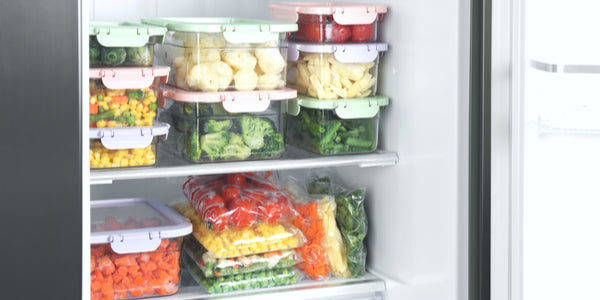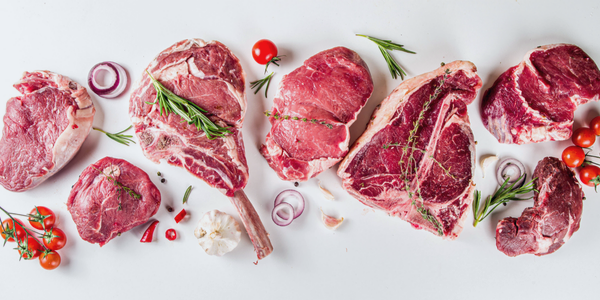
One of the best ways to eat healthier is arguably to increase fruit and vegetable intake. However, buying more fruits and vegetables at the store does not always mean eating more fruits and veggies.
Unfortunately, fruits and vegetables can seem to go bad quickly before using and are one of the highest categories of food waste according to a 2018 article. Fruits, vegetables, and mixed vegetable dishes made up about 40 percent of the nearly 150,000 tons of food waste per day.
Using produce before it goes bad can be helpful for budgeting, health, and the environment.
Find out how to keep vegetables fresh without a fridge, ways to use overripe fruits, and other storage tips can help minimize food waste and make the most out of produce!
Proper Produce Storage
Before even putting produce away, one can minimize fruits and vegetables going bad too quickly. For optimal storage length, choose delicate fruits and vegetables like berries and leafy greens that are free of bruises and not wilted, discolored, or appear mushy.
Not all produce needs to go in the fridge for optimal freshness, and HOW fruits and veggies are stored in the fridge can impact their longevity. Simply storing some fruits and vegetables separately can also improve how long they last whether in the fridge or room temperature.
Keeping Produce Fresh in the Fridge
According to a 2020 New York Times article, most produce can last longer in the fridge when in a sealed container like a zipped plastic bag or a container with a tight lid. Avoid washing berries, mushrooms, grapes, and leafy greens before storing in the refrigerator to reduce the risk of quick spoilage.
Other fruits and vegetables ideal for storing in the fridge include:
• Any peeled or pre-cut fruits or vegetables
• Apples and citrus fruits (for use longer than 2 weeks)
• Beets, broccoli, carrots, cauliflower, celery, green beans, radishes
• Corn on the cob (keep in cob for optimal freshness)
• Ripe stone fruits, mangoes, and melons
Broccoli and cauliflower should be kept away from other fruits and vegetables in the fridge for optimal freshness. Ideally, store produce in the crisper drawers on the bottom of the refrigerator instead of on other shelves.
Keeping Produce Fresh Without a Fridge
Some fruits and vegetables can last longer when kept out of the fridge. For example, cucumbers, peppers, eggplant, and tomatoes should be left out at room temperature instead of the fridge to maximize their freshness. Root vegetables like onions, garlic, and potatoes should not be kept in the fridge but in a cool, dark space. If stored in the fridge, use within a few days for optimal freshness.
Apples and pears can be stored out of the fridge if eaten within a week. One important note of bananas, apples, and pears is they are considered ethylene gas-producing fruit. Placing these fruits next to other fruits or vegetables, including avocados and peaches, can expedite their ripening.
In general, taking fruits out of plastic bags can help with keeping them fresh outside the fridge. It is also best to store unripe fruit, like mangoes or stone fruit, outside of the fridge. If these fruits ripen too fast before use, place them in the fridge to slow the ripening process.
What to Do With Overripe Fruits and Vegetables
If fruits or vegetables start to ripen too fast before consumed, do throw them out just yet! There are many good ideas and delicious ways to use even if they are a little past their ideal stage.
Freezing Fruit & Veggies
One of the easiest ways to save overripe fruit or leftover vegetables is to freeze them before they become moldy and completely inedible. Freezing fruits and vegetables stops the ripening process and can drastically slow the growth of harmful microorganisms.
Produce with blemishes or are more ripe/soft than desired can be saved from being thrown out if frozen. Before freezing, though, make sure to store in plastic or glass freezer containers or bags to minimize freezer burn.
Vegetables are best stored frozen after blanching, a cooking process that only slightly cooks a vegetable in boiling water for a short time. Most fruits and berries can also be frozen as is, especially if they are:
• Peeled (bananas, mangoes)
• Pitted (peaches, plums, cherries)
• De-stemmed (strawberries)
• Chunked into smaller pieces (apples, bananas, mango)
Other tips and tidbits for freezing produce include:
• Write the date on the freezer container so the oldest produce is used first. Rotate the fruits and vegetables.
• Keep the freezer 3/4 stocked for optimal efficiency and do not overcrowd the freezer. If you don’t have room in your freezer for ripe fruits or vegetables, see if a friend or neighbor can store or might want.
• Fruits that become unthawed can ferment which can mean they start to spoil. This will not make them dangerous to eat but will affect the flavor. Defrosted fruits that smell and taste good can be refrozen.
• Be aware that some veggies can change flavor and texture when frozen, including onions and potatoes. New potatoes may be best for freezing for later use.
• Know not all vegetables are ideal for freezing. Lettuce, tomatoes, celery, cucumbers, parsley, radishes, and similar high-water-content vegetables can become limp and watery after freezing.
• Aim to use frozen fruits and vegetables within 1 year of freezing.
Use Ripe Fruits or Vegetables Blended or Cooked
Whether frozen or still fresh, overripe fruits and vegetables that are still edible (and not rotten) can be used in dishes. They may not be ideal for raw consumption, but they can still work great for flavor!
Overripe bananas are a great example of repurposing fruits, particularly to bake a delicious banana bread! Frozen, peeled chunks, or slices of bananas and other frozen fruits can be a good base for blending smoothies and making jams.
Onions, peppers, carrots or other root vegetables a touch past their prime can be used in soups, egg dishes, stir-fries, or other mixed dishes.
Does Frozen Produce Lose Its Nutrients?
Frozen fruits and vegetables do not vary significantly nutritionally from fresh fruits and vegetables. The determinant for any fruit or vegetable’s nutritional value can depend on when they were harvested and any processing since harvesting.
In fact, fruits and vegetables that are going to be directly harvested for frozen packaging may stay on the vine or in the ground longer than fresh fruits and vegetables. Some fresh fruits and vegetables are picked when they are unripe and ripen during transportation, which can vary from days to weeks.
Frozen fruits and vegetables can be a practical choice instead of fresh fruits and vegetables to cut down on waste without compromising nutrition. They may also be more affordable especially in winter months when in many parts of the US produce is not in season.
Reference:
American Heart Association: Keep Fruits and Vegetables Fresher Longer. https://www.heart.org/en/healthy-living/healthy-eating/add-color/keep-fruits--vegetables-fresher-longer.







